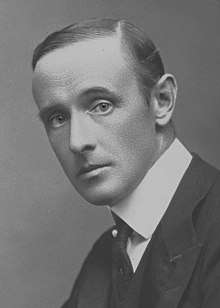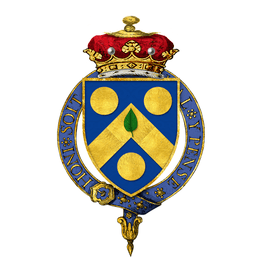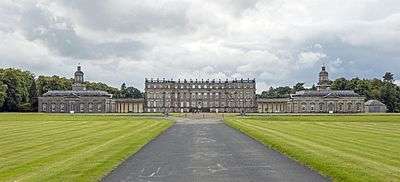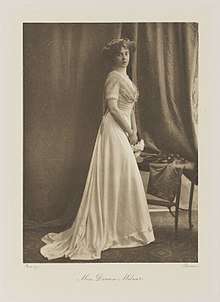Victor Hope, 2nd Marquess of Linlithgow
| The Most Honourable The Marquess of Linlithgow KG KT GCSI GCIE OBE TD PC | |
|---|---|
 | |
| Viceroy of India | |
|
In office 18 April 1936 – 1 October 1943 | |
| Monarch |
Edward VIII George VI |
| Prime Minister |
Stanley Baldwin Neville Chamberlain Winston Churchill |
| Preceded by | The Marquess of Willingdon |
| Succeeded by | The Viscount Wavell |
| Personal details | |
| Born |
24 September 1887 South Queensferry, Linlithgowshire, Scotland |
| Died |
5 January 1952 (aged 64) South Queensferry, Linlithgowshire, Scotland |
| Spouse(s) |
Doreen Maud Milner (1911–1952) |

Victor Alexander John Hope, 2nd Marquess of Linlithgow, KG, KT, FRSE, GCSI, GCIE, OBE (24 September 1887 – 5 January 1952) was a British Unionist politician, agriculturalist and colonial administrator. He served as Governor-General and Viceroy of India from 1936 to 1943. He was usually referred to simply as Linlithgow.
He served as vice president of the Royal Society of Edinburgh, Chancellor of the University of Edinburgh and Lord High Commissioner to the General Assembly of the Church of Scotland.
Early life and family
Hope was born at Hopetoun House, South Queensferry, Linlithgowshire, Scotland, on 24 September 1887.
He was the eldest son of John Adrian Louis Hope, 7th Earl of Hopetoun, later 1st Marquess Linlithgow, and Hersey Everleigh-de-Moleyns, Countess of Hopetoun and later Marchioness of Linlithgow, daughter of the fourth Baron Ventry.[1] His godmother was Queen Victoria.[2]
He was educated at Eton College and on 29 February 1908 succeeded his father as 2nd Marquess Linlithgow.
In 1912, aged only 25, he was elected a Fellow of the Royal Society of Edinburgh. His proposers were William Turner, Alexander Crum Brown, Cargill Gilston Knott and James Haig Ferguson. He served as the Society's Vice President from 1934 to 1937.[3]
Early career
Linlithgow served as an officer on the Western Front during the First World War. Transferred from Lothians and Border Horse, he commanded a battalion of the Royal Scots. He was mentioned in dispatches and appointed an Officer of the Order of the British Empire, ending the war with the rank of Colonel.
He then served in various minor roles in the Conservative governments of the 1920s and '30s. From 1922 till 1924 he served as the civil lord of the Admiralty, becoming chairman of the Unionist Party Organisation in 1924 for two years. He also served as president of the Navy League from 1924 until 1931. He was chairman of the Medical Research Council and of the governing body of the Imperial College London. Linlithgow was also chairman of the committee on the distribution and prices of agricultural produce and president of the Edinburgh and East of Scotland College of Agriculture until 1933. In 1926 he was chairman of the Royal Commission on Agriculture in India, which published its findings in 1928.[4] Influenced by submissions to the Royal Commission, "a decade later, when (he) became Viceroy of India he showed a personal interest in nutrition, pushing it to the top of the research agenda".[5]
From April 1933 to November 1934 he was chairman of the Parliamentary Joint Select Committee on Indian constitutional reform, drawn up to consider the proposals for Indian self-government contained in the government's March 1933 White Paper. He agreed to take the job after Lord Salisbury declined it (although he agreed to serve on the committee) and Sidney Peel, the second choice, fell ill with phlebitis. Linlithgow told the Joint Select Committee that he would show no favouritism between the Indian factions (Hindus, Muslims and Princely States) and would be neutral just as he was between his own five children. The committee's proposals became the Government of India Act 1935.[6]
Viceroy

Having previously declined both the governorship of Madras and the governor-generalship of Australia (his father was the first Governor-General of Australia),[7] he became the Viceroy of India,[1] succeeding Lord Willingdon. Travelling out to India on the P&O liner RMS Strathmore, he arrived in Bombay, with his wife, daughters, and personal staff, on 17 April 1936.[8] Linlithgow implemented the plans for local self-government embodied in the Government of India Act 1935, which led to provincial governments led by the Congress Party in five of the eleven provinces of British India, but the recalcitrance of the princes prevented the establishment of elected governments in most of the princely states.
With the outbreak of the Second World War, Linlithgow's appeal for unity led to the resignation of the Congress ministries. On 8 August 1940 Lord Linlithgow made a statement on behalf of the British government. It was known as the August Offer and offered greater rights in the governance of India to the Indian people. The proposal was rejected by most Indian politicians, including the Congress Party and the Muslim League. Disputes between the British administration and Congress ultimately led to massive Indian civil disobedience in the Quit India Movement in 1942. Linlithgow suppressed the disturbances and arrested the Congress leaders. He is partly blamed for the Bengal famine of 1943.[9]
Retirement
His seven-year tenure as viceroy, the longest in the history of the Raj, ended in 1943. He was considered by his British obituarists to have been "one of the most skillful colonial officers to have held the highest office".
Indians were less kind in their assessments of his career. V. P. Menon in The Transfer of Power in India stated: "His 7½ year regime – longer than that of any other Viceroy – was conspicuous by its lack of positive achievement. When he left India, famine stalked portions of the countryside. There was economic distress due to the rising cost of living and the shortage of essential commodities. On the political side, Sir Tej Bahadur Sapru expressed the general feeling thus: 'Today, I say, after seven years of Lord Linlithgow's administration the country is much more divided than it was when he came here'."
A sincere Presbyterian, he served as Lord High Commissioner to the Church of Scotland in 1944 and 1945. He died in 1952.
Styles
- 1887–1902: Victor Alexander John Hope, Viscount Aithrie
- 1902–1908: Victor Alexander John Hope, Earl of Hopetoun
- 1908–1917: The Most Honourable The Marquess of Linlithgow
- 1917–1919: The Most Honourable The Marquess of Linlithgow, TD
- 1919–1928: The Most Honourable The Marquess of Linlithgow, OBE, TD
- 1928–1929: The Most Honourable The Marquess of Linlithgow, KT, OBE, TD
- 1929–1935: The Most Honourable The Marquess of Linlithgow, KT, GCIE, OBE, TD
- 1935–1936: The Most Honourable The Marquess of Linlithgow, KT, GCIE, OBE, TD, PC
- 1936–1943: His Excellency The Most Honourable The Marquess of Linlithgow, Viceroy and Governor-General of India, KT, GCSI, GCIE, OBE, TD, PC
- 1943–1952: The Most Honourable The Marquess of Linlithgow, KG, KT, GCSI, GCIE, OBE, TD, PC
- in Scotland: May 1944, May 1945: His Grace The Lord High Commissioner
Family

On 19 April 1911 he married Doreen Maud Milner (1886–1965), the younger daughter of Sir Frederick Milner.[10] They had twin sons and three daughters:
- Charles William Frederick Hope, 3rd Marquess of Linlithgow (7 April 1912 – 1987); succeeded to his father's marquessate
- John Hope, 1st Baron Glendevon (7 April 1912 – 18 January 1996); became a Conservative statesman and married the daughter of the English novelist W. Somerset Maugham
- Lady Anne Adeline (born 27 January 1914 - died 2007[11])
- Lady Joan Isabella (born 21 September 1915 - died 1989[12])
- Lady Doreen Hersey Winifred (born 17 June 1920 - 22 January 1997[13]), the mother of Lucinda Green, a famous equestrian.
In some circles the three girls were known as Faint Hope, Little Hope and No Hope.[14]
Book used for citation
- Butler, Rab (1971). The Art of the Possible. London: Hamish Hamilton. ISBN 978-0241020074. , his autobiography
References
- 1 2 Viceroy at Bay: Lord Linlithgow in India, 1936-43, by John Glendevon
- ↑ Dictionary of Australian Artists Online
- ↑ Biographical Index of Former Fellows of the Royal Society of Edinburgh 1783–2002 (PDF). The Royal Society of Edinburgh. July 2006. ISBN 0 902 198 84 X.
- ↑ Linlithgow (Chairman); et al. (1928), Royal Commission on Agriculture in India. Volume I, Part II, Calcutta: Government of India, Central Publication Branch, retrieved 12 August 2010 (Full text at Internet Archive)
- ↑ Arnold, David (2000), Science, technology, and medicine in Colonial India, The New Cambridge History of India. Part III, Volume 5, Cambridge, UK: Cambridge University Press, p. 201, ISBN 0-521-56319-4, retrieved 12 August 2010
- ↑ Butler 1971, pp.46-55
- ↑ Cunneen, Chris. Australian Dictionary of Biography. National Centre of Biography, Australian National University. Retrieved 3 April 2018 – via Australian Dictionary of Biography.
- ↑ News and Views (1936), p. 5: "Lord and Lady Linlithgow, together with their three daughters and personal staff, arrived by the new P & O liner S. S. Strathmore on Friday, April 17, in the early morning, and were escorted into Bombay harbor by the ships of the Royal Indian Navy".
- ↑ Richard Stevenson, Bengal Tiger and British Lion: An Account of the Bengal Famine of 1943
- ↑ John Glendevon, Viceroy at Bay: Lord Linlithgow in India, 1936-43
- ↑ "Lady Anne Adeline Southby (née Hope) - Person - National Portrait Gallery". www.npg.org.uk. Retrieved 3 April 2018.
- ↑ "Lady Joan Isabella Gore-Langton (née Hope) - Person - National Portrait Gallery". www.npg.org.uk. Retrieved 3 April 2018.
- ↑ "Lady Doreen Prior-Palmer". HeraldScotland. Retrieved 3 April 2018.
- ↑ "Lt-Col James Allason: War hero who became an MP and formulated the Tory policy of selling council houses to tenants". The Independent. London. 23 June 2011.
External links
- Newspaper clippings about Victor Hope, 2nd Marquess of Linlithgow in the 20th Century Press Archives of the German National Library of Economics (ZBW)
| Government offices | ||
|---|---|---|
| Preceded by The Earl of Willingdon |
Viceroy of India 1936–1943 |
Succeeded by The Viscount Wavell |
| Honorary titles | ||
| Preceded by The Earl of Rosebery |
Lord Lieutenant of West Lothian 1929–1952 |
Succeeded by Henry Moubray Cadell |
| Academic offices | ||
| Preceded by Baron Tweedsmuir |
Chancellor of the University of Edinburgh 1946–1952 |
Succeeded by HRH The Duke of Edinburgh |
| Peerage of the United Kingdom | ||
| Preceded by John Adrian Louis Hope |
Marquess of Linlithgow 1908–1952 |
Succeeded by Charles William Frederick Hope |
.svg.png)
.svg.png)
.svg.png)